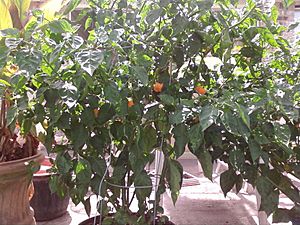Ají dulce facts for kids
Quick facts for kids Ají dulce |
|
|---|---|

Puerto Rican ajicitos
|
|
| Species | Capsicum chinense |
| Origin | Latin America and the Caribbean |
| Heat | |
| Scoville scale | 0–500 SHU |
Ají dulce, also known as ají cachucha, quechucha, ajicito, or ají gustoso, is a type of sweet pepper. These peppers are found in Latin America and the Caribbean. They are a kind of Capsicum chinense, which is the same plant family as the very spicy habanero pepper.
However, ají dulce peppers are much milder. They have a unique, smoky flavor. These peppers are very popular in countries like Cuba, Jamaica, Puerto Rico, Dominican Republic, and Venezuela. In the English-speaking Caribbean, people often call them "seasoning peppers." They are a key ingredient in many traditional dishes there.
Contents
What Do the Names Mean?
The name ají dulce comes from Spanish. Ají means "chili pepper" and dulce means "sweet." So, ají dulce means "sweet chili pepper."
- Ají cachucha: Cachucha is a word for a cap. This name refers to the pepper's cap-like shape.
- Ají gustoso: Gustoso means "tasty." So, this name means "tasty chili pepper."
- Ajicito: This is a small version of ají. It means "little chili pepper."
How Ají Dulce Is Used in Cooking
Ají dulce peppers are an important part of many dishes. They add a special flavor without too much heat.
Venezuelan Dishes
In Venezuelan cuisine, ají dulce is a main ingredient. It is used in many traditional meals. One example is pabellón criollo, which is a national dish. Venezuelan ají dulce is not spicy. It scores between 100 and 500 on the Scoville scale. The Scoville scale measures how hot a pepper is. A jalapeño pepper, for example, can be 2,000 to 8,000 Scoville units.
Caribbean Cooking
- In the Dominican Republic, this pepper is called "ají gustoso."
- In Cuba, it is known as ají Cachucha.
- In Puerto Rico, it is called ají dulce or ajicito. Farmers grow it there to sell. It is used in many sauces, such as recaíto, sofrito, and mojito isleño. It also goes into fish or meat sauces, stews, rice, and other local dishes.
See also
 In Spanish: Pimiento morrón para niños
In Spanish: Pimiento morrón para niños


